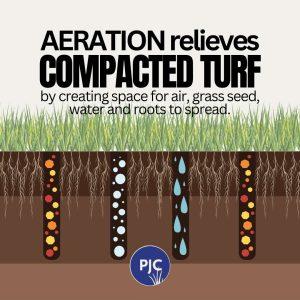Pros of Aerating
Deciding whether to aerate and overseed this spring? Our last blog covered the pros and cons of seed slicing—now let’s get on to aerating…A core aerator pulls plugs of soil and deposits them above ground. This opens up space for air, grass seed and water to enter the soil, and for turf-grass roots to spread.
Noteably, core aeration is our best mechanical measure to alleviate highly compacted areas. Athletic fields are highly susceptible to compaction and most weeds that thrive on athletic fields are a result of compaction, which can bind calcium or limit pore space for grass roots to thrive. Spring aerations with fast germinating Rye Grass present your best opportunity to establish new turf grass in short windows and give you more turf coverage going into the heat of summer.

Cons of Aerating
However, as cores are brought to the surface, there’s risk that weed seeds are also brought to the surface and given a chance to germinate. These weed seeds would have otherwise remained buried and the existing turf cover would have kept them at bay. Due to this potential risk, core aeration should be avoided on residential lawns in the spring unless the area is so compacted that water can’t filtrate the soil profile.
Aeration and overseeding is highly labor intensive and — while the soil and turf benefits are outstanding – it can be difficult for landscapers or athletic field managers to keep on top of other practices like mowing and irrigation repairs. Therefore, be sure to schedule your time well and don’t miss the opportunities to best improve your playing surfaces.
The Importance of Grass Seed
In an Organic Turf Care (OTC) program, the best all-natural weed control is grass seed. Soil temperature, germination timeframes, and pH all affect growing healthy grass. In the Northeast, the window to overseed caps by the end of May.
When deciding whether to aerate and overseed, choosing the right grass seed blend is important. Whether dealing with residential or athletic fields, the goal is to get coverage as quickly as possible. Remember: quick coverage helps suppress weeds.
Note: Since it can take up to 18 months for grass to become fully established from seed, anticipate some die off from spring over-seeding as you enter the heat of the summer. Plan to follow up with a second overseed in the fall. If budget only allows for one over-seed a season, wait until fall. Fall is the best window to focus on establishing grass from seed to thicken the lawn.
